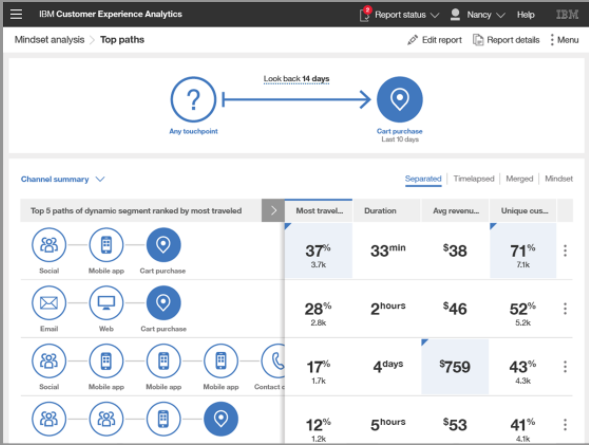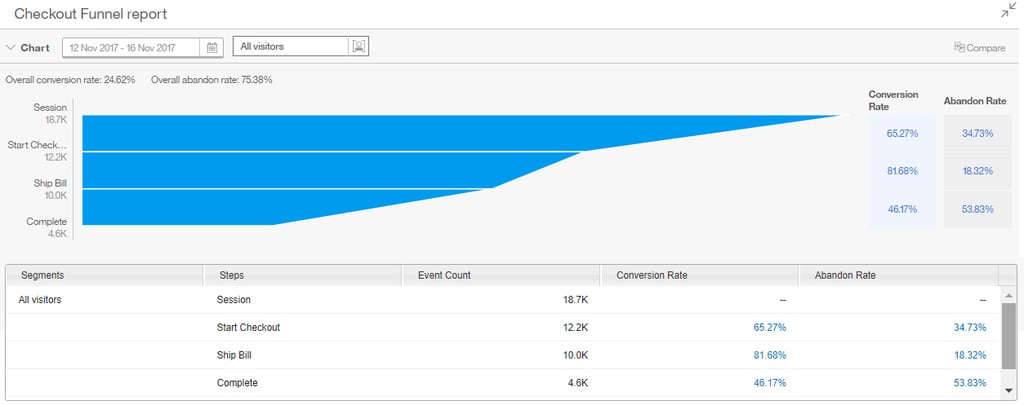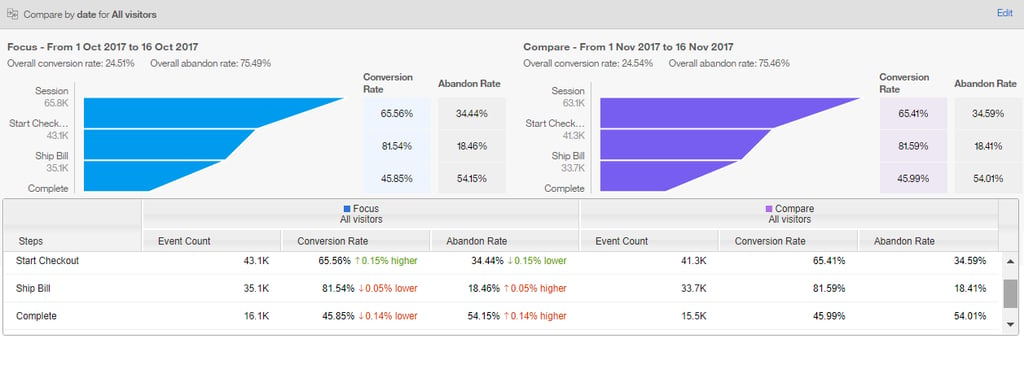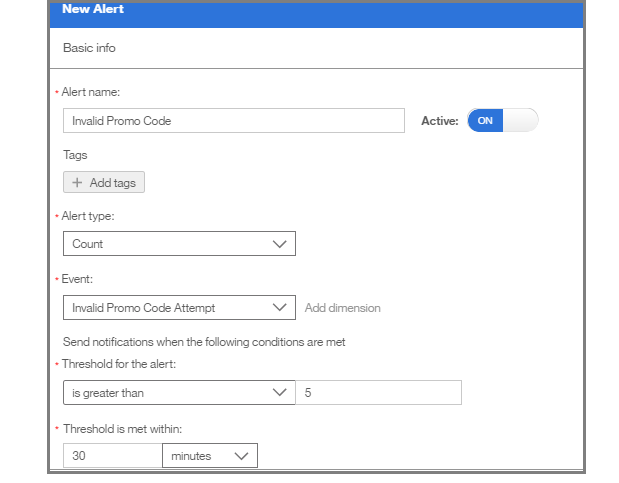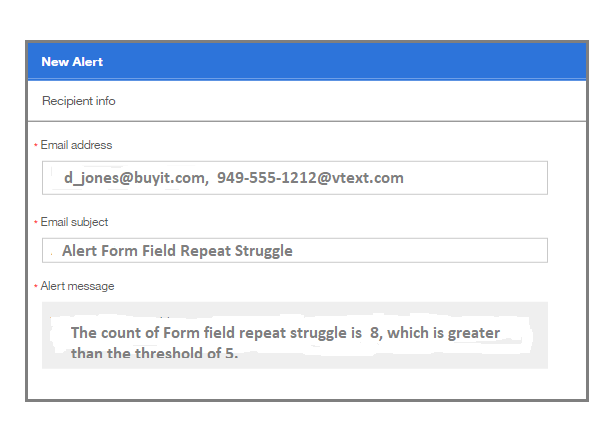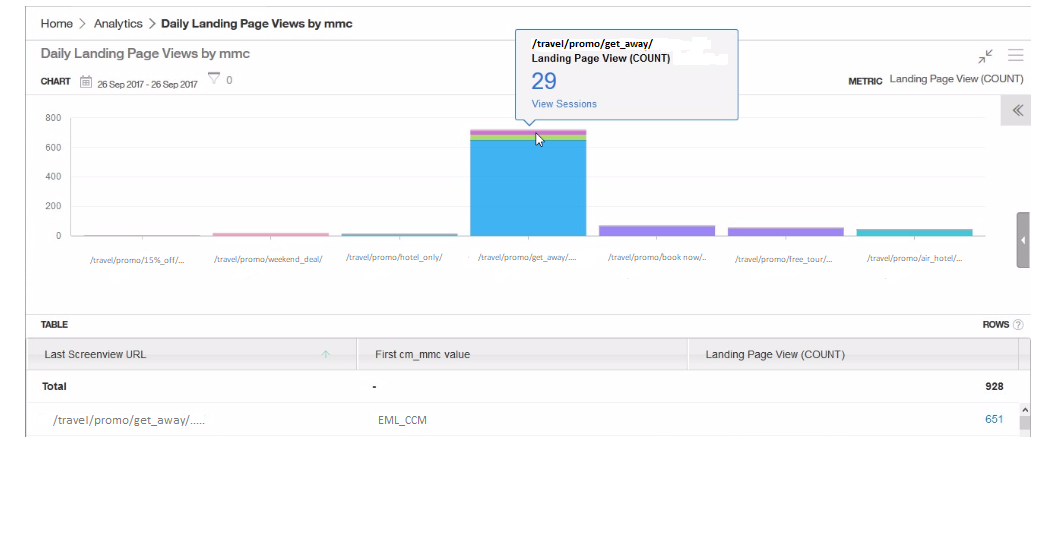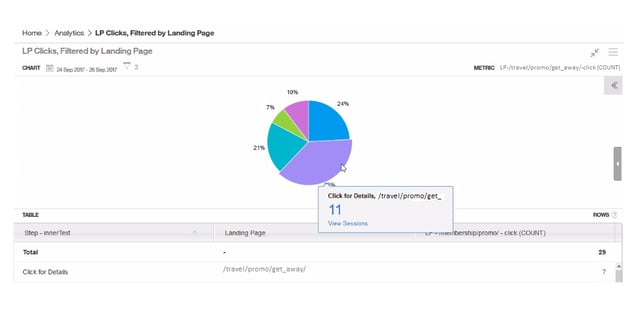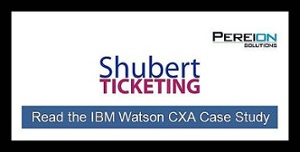Introduction
Customers today have come to consistently expect optimal online experiences. Deliver anything less and you run the risk of not converting a user or potentially losing a loyal customer. A crucial first step in the process of optimizing your customer experiences is your ability to quickly discover, understand and minimize customer struggle on your site.
Analysis Overview
By utilizing Struggle Analytics, a cognitive feature in Watson Customer Experience Analytics (CXA), you can easily monitor specific processes or promotional pages on your site to quickly identify customer struggle and uncover areas of opportunity to improve and optimize your customer experiences.
Analysis Benefits:
- Easily monitor specific processes or promotional pages for struggle activity with minimal configuration effort
- Create struggle factors based on pertinent events in your system and relative to your business focus
- Quickly discover obstacles to superior customer experience on your site by setting alerts to be notified when struggle thresholds are exceeded, allowing you to take swift action to eliminate struggle before it becomes prevalent.
- Employ session replay technology to view the customer struggle identified and rectify issues to optimize customer experiences on your site.
Analysis Formula
This customer experience analytics (CXA) formula will explain how to use Struggle Analytics in Watson CXA to effectively monitor specific processes, pages and events on your site for struggle activity, allowing you to quickly detect and analyze customer struggles and take corrective action to rectify issues and deliver frictionless customer experiences.
How Struggle Analytics work
Struggle Analytics is a cognitive feature that uses algorithms to learn over time what is normal user behavior on a page and what is not and assigns a struggle score based on struggle factors. The struggle score is calculated from weighted default factors and struggle event factors, and factors are weighed on a scale of 1 to 10.
By default, struggle factors for events in Watson CXA are calculated for a page URL or screen based on the following core attributes:
- Repeat pattern – repeated patterns of unproductive user actions
- Step count – number of user-initiated actions on a page such as clicks and entering text
- Load time for page in seconds
- UI element -- detect issues with UI elements, such as a user repeatedly clicking an icon
Note: There is also the option to add user-defined events as struggle factors, allowing you to closely monitor and weight variables that are specific to your particular business. Elements to consider could include abandonment events, error pages, no results searches, or events that capture struggle for customers in a particular region, etc.
Consider the pages you want to analyze for customer struggle
Customer struggle can vary depending on your site design or business focus, but some examples of struggles you may want to monitor could include users entering multiple credit card numbers (i.e. potential fraudulent activity) on your check out page, struggling with a form field (i.e. user confusion) on your registration page or having to wait extended periods of time for a page to load (i.e. poor or invalid web design) on your product page or shopping cart page.
Configure Struggle Analytics for your application
Step 1 - Map pages and prepare application for analysis
- Select Struggle Analytics in Watson CXA and then from the Options menu in the upper right corner, select Map Page.
- Select Configure from the left side and enter a recognizable name for your mapped page or you can use the provided pages and icons to name your pages.
- Then enter the page URL you want to monitor and select the appropriate conditions you want to include for your page mapping. The conditions that you specify can be And or OR and are based on the page URL or an Event.
- Next, test the set conditions against existing sessions by selecting Test Pages in the lower left. Then, resolve any issues that are shown in the Test results window.
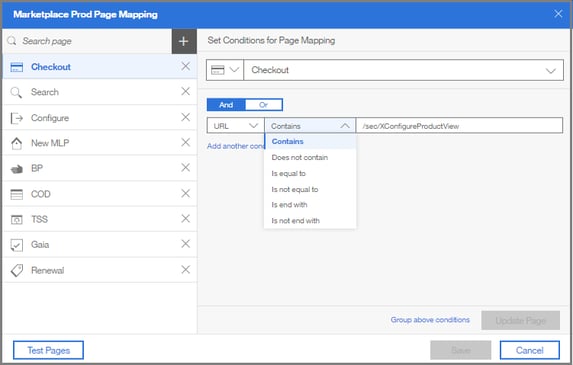
Page mapping for Struggle Analytics displayed in Watson CXA
When all of your page maps have been added and tested, the Struggle Analytics service will begin to analyze customer struggle in sessions for the mapped application. It takes about 10 minutes for the Struggle Analytics service in Watson CXA to begin posting results. The generated struggle report will identify customer struggle for your mapped pages using a set of algorithms based on key struggle factors and a struggle score will be assigned.
Modify the default configuration for Struggle Factors
Struggle Analytics provides a predefined configuration for load time, step count, repeat pattern and UI element struggle factors. However, Watson CXA allows you the option to modify the configuration for struggle factors that are taken into consideration in the algorithm. You can change the weight (significance/importance) of a factor, add event-based factors, or exclude a struggle factor from being calculated on a particular page. The ability to modify the configuration for Struggle Factors is helpful if you want to shift your focus to a particular area as your analysis becomes more specific over time.
Step 2 - Modify configuration for struggle factors:
- Click Options in the upper right corner
- Select Edit Struggle Factor from the menu
- The associated Default Factors and Struggle Event Factors are displayed.
- Adjust the struggle factor weight by sliding the circle left to right.
- Add an UI element factor by clicking on the plus sign “+” next to Default Factors
- Add an event-based factor by clicking the plus sign “+” next to Struggle Event Factors
- Click Save in the lower right to save your selections.
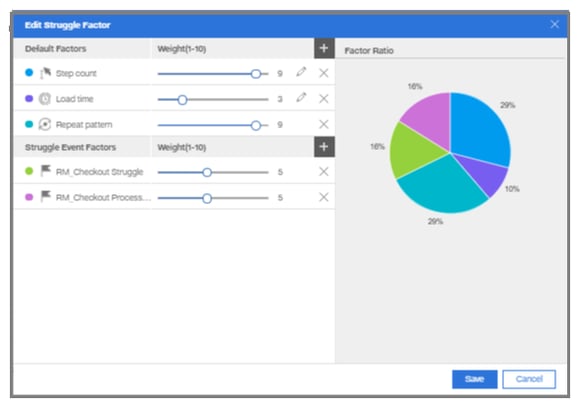
Edit Struggle Factor for Struggle Analytics displayed in Watson CXA
Modify the configuration for Struggle Thresholds
You have the option in Struggle Analytics to edit the configuration for Struggle Thresholds, allowing you to make modifications to struggle thresholds that are most relevant to business on your site.
- The struggle score threshold is the maximum struggle score that is acceptable, or considered within normal range, for a session and is based on the total struggle score for a session.
- The Percentage of sessions demonstrating struggleis the percentage of sessions that have a struggle score that is greater that the struggle score threshold.
For example, in the screenshot below, the struggle score threshold is set to 80 and the Percentage of sessions demonstrating struggle is set to 5%. If you have enabled the option to receive alerts, an alert will be sent if and when it is detected that 5% of the sessions are showing a struggle score of 80 or more.
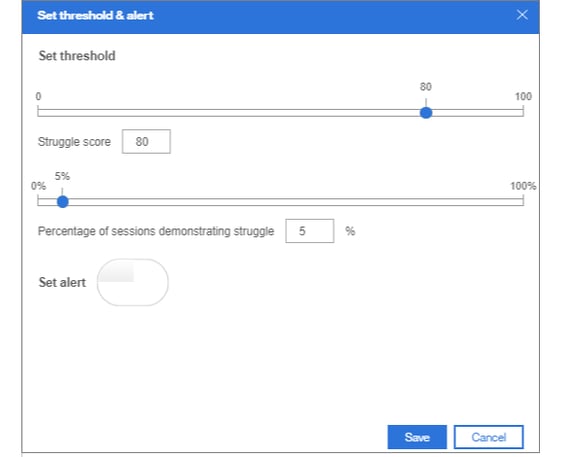
Edit Struggle Factor for Struggle Analytics displayed in Watson CXA
Step 3 - Modify the configuration for Struggle Threshold
- Click Menu in the upper right corner
- Select Set Threshold & Alert from the menu
- As shown in the above image, the configuration screen will appear where you can:
- Edit the struggle score threshold
- Adjust the percentage of sessions demonstrating struggle
Understand and Use the Struggle Analytics data
The reports generated by Struggle Analytics display the sessions that match the page mapping conditions and struggle score and percentage that you set. Highlighted are the top 10 struggling sessions, the session struggle score, and the session struggle indicators and number of instances of each struggle indicator. From the details page, you can view the median load time, step count, and UI element struggle for the struggling page or event.
Utilizing session replay technology in Watson CXA, you can then drill deeper and replay the sessions that included struggle activity and view the actual struggle, allowing you to easily identify the source of struggle and take quick action to rectify issues and optimize the customer experience on your site.
-resized-600.jpg?width=600&height=157&name=Pereion__Logo_(640x167)-resized-600.jpg)


